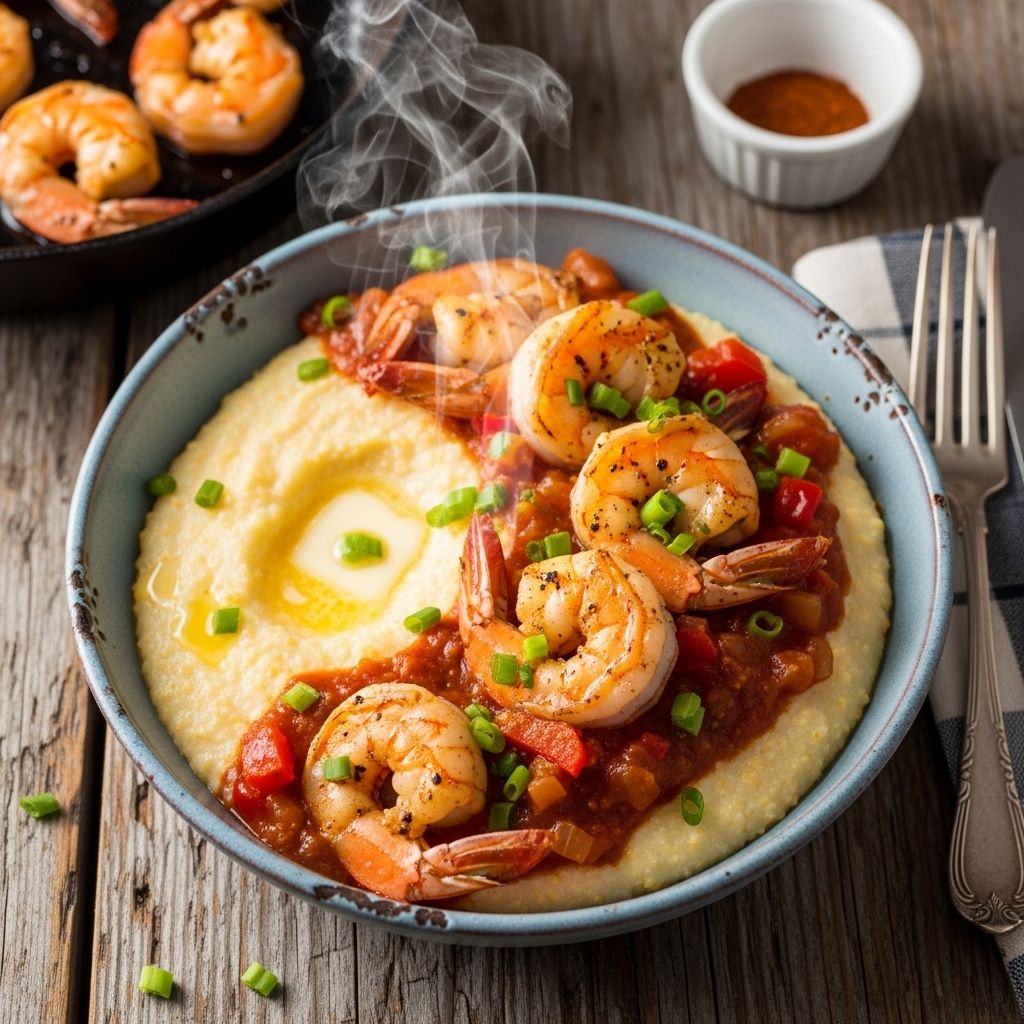Shrimp and Grits: A Deep Dive Into Southern Food History
Discover how coastal traditions and immigrant ingenuity transformed simple corn porridge into a culinary icon.

It’s hard to picture a Southern brunch table without a bowl of shrimp and grits, its creamy texture and briny shrimp signaling both comfort and tradition. But like so many beloved American dishes, shrimp and grits tells a story—one of geography, culture, culinary adaptation, and the blending of influences over centuries. This article traces the journey of shrimp and grits from its earliest roots in coastal Carolina to its iconic status in contemporary Southern cuisine.
What Are Grits?
Grits are a simple dish made by grinding dried corn—traditionally hominy—into a coarse meal, then cooking it slowly in water or milk. The resulting porridge has been a staple food in the southeastern United States for centuries, enjoyed both savory and sweet. The texture can vary from creamy to grainy, but the comfort is constant.
Origins: Native American Roots
Before grits formed the basis of a Southern breakfast, they were central to the diet of Native American tribes in the southeast. Tribes like the Creek, Cherokee, and Chickasaw cultivated corn and prepared it in many ways, teaching European settlers how to make cornmeal dishes such as grits. The process—grinding dried corn in stone mills and simmering it in water—laid the foundation for grits as we know them today.
- Corn was a vital crop for indigenous people, sustaining whole communities during times when other food sources were scarce.
- Hominy vs. Grits: While ‘hominy’ refers to whole corn kernels treated with alkali, in coastal Carolina ‘hominy’ historically became synonymous with grits, blurring the culinary distinction in local vocabulary.
African and African American Influence
With the transatlantic slave trade came new food traditions and adaptations. Enslaved Africans brought with them knowledge of cultivating and preparing corn, as well as the practice of cooking with seafood. Food historian Michael Twitty has traced connections between corn-based dishes and shellfish stews found in Mozambique and other parts of Africa, suggesting that the pairing of grits and shrimp existed in African cooking long before it arrived in Charleston.
- Grits provided cheap sustenance for enslaved people on Southern plantations, becoming a staple food due to affordability and filling nature.
- Shrimp was accessible along the marshy coastlines of South Carolina and Georgia, where enslaved people and poor laborers often relied on local seafood catches.
- The combination of shrimp and grits—born out of necessity and availability—became a fisherman’s breakfast in the low-lying marshes of Carolina.
Lowcountry Culinary Traditions
The Lowcountry region—which includes coastal South Carolina and Georgia—was the heartland of the early grits-and-shrimp pairing. Fishermen and families cooked fresh shrimp with whatever vegetables were available and served them over bowls of hot grits for a hearty start to the day.
- The dish was initially known as shrimp and hominy or breakfast shrimp, and appeared as a simple, rustic meal in working-class homes.
- Gullah culture, prevalent in the Sea Islands, carried, developed, and preserved the tradition, enriching it with African flavors and cooking methods.
- The first official recipe for “Breakfast Shrimp” surfaced in the 1950 Charleston Receipts cookbook, describing a method for sautéing small shrimp with onion and peppers in bacon grease, thickening the sauce, and serving it with grits.
The Evolution Into a Southern Classic
Though its origins are humble, shrimp and grits began to appear in restaurant kitchens as Southern culinary pride grew in the late 20th century. Several key developments pushed the dish into the national spotlight:
- Chef Bill Neal of Crook’s Corner in Chapel Hill, North Carolina, is widely credited with transforming shrimp and grits into a restaurant staple. In the early 1980s, Neal added cheese and bacon to the classic recipe, elevating it with creamy Parmesan, sharp cheddar, and crisp bacon bits. His version was hearty, complex, and immediately popular.
- The innovation attracted attention from food critics including Craig Claiborne of The New York Times, who published the recipe and helped it spread rapidly beyond the South.
- Shrimp and grits transformed from a fisherman’s breakfast to a brunch sensation, finding its way into both upscale restaurants and casual seafood shacks.
Fernandina’s Shrimping History: A Detour to Florida
While South Carolina stands as the birthplace, Florida’s shrimping industry played a role in making fresh shrimp more accessible in the broader Southern region. In the early 1900s, Italian immigrant Mike Salvador arrived in Fernandina Beach, Florida, leveraging European shrimping expertise to establish large-scale shrimp harvesting. This local supply further democratized dishes like shrimp and grits, especially as returning World War II soldiers brought back a taste for seafood.
Regional Variation and Modern Interpretations
The beauty of shrimp and grits lies in its adaptability. Today, chefs experiment freely, layering flavors and textures, and personalizing their plates with regional ingredients. Some customs and options include:
- Stone-ground white or yellow grits: Texture, flavor, and color vary based on artisanal preparation.
- Shrimp sautéed with onions, green peppers, mushrooms, garlic, and bacon.
- Cheese grits: Cheddar, Parmesan, or goat cheese amp up the richness.
- Creole variations: Incorporate tomatoes, cayenne, and green onions.
- Herbs and gravies: Fresh tarragon, parsley, scallions, or seafood gravy add depth.
| Component | Traditional Preparation | Modern Variations |
|---|---|---|
| Shrimp | Sautéed in bacon or butter, simple seasoning | With sausage, mushrooms, in seafood gravy, spicy rubs |
| Grits | Plain, stone-ground, simmered with water or milk | Cheesy, creamy, with herbs, made with stock or cream |
| Flavorings | Salt, pepper, onions, bell peppers | Scallions, leeks, garlic, fresh herbs, smoked paprika |
| Presentation | Bowl, breakfast dish | Plated as an entrée, brunch specialty, tapas |
Cultural Impact and Significance
Beyond flavor, shrimp and grits encapsulates the South’s complicated history—its blend of Native American, African, and European influences, and the legacy of resourcefulness in the face of hardship. It embodies the region’s agricultural bounty, culinary creativity, and pride in local ingredients. Today, the dish bridges communities and generations, bringing together old traditions with new techniques.
- Shrimp and grits is a fixture on menus from Atlanta to Charleston and beyond.
- It’s recognized nationally as a symbol of Southern comfort food.
- The dish continually evolves, reflecting both history and future innovation.
Classic Recipe Overview
While every chef brings their own spin, the core of shrimp and grits remains simple:
- Stone-ground grits, slowly cooked with water, milk, or broth.
- Shrimp sautéed with bacon, onions, and peppers.
- Seasoning with salt, pepper, and sometimes seafood gravy or cheese.
Optional extras include mushrooms, tomatoes, garlic, scallions, and a garnish of fresh herbs or hot sauce.
Frequently Asked Questions (FAQs)
Q: Where did shrimp and grits originate?
A: The dish originated along the coastal Lowcountry region of South Carolina and Georgia, deeply shaped by Native American, African American, and Gullah culinary traditions.
Q: Are grits the same as hominy?
A: No. While ‘hominy’ refers to whole corn kernels treated with lye, ‘grits’ are coarsely ground corn. In South Carolina, the terms have sometimes been used interchangeably, but they’re technically distinct.
Q: What makes modern shrimp and grits different from the original?
A: Today’s recipes often include cheese, herbs, and more elaborate sauces, whereas the original was a hearty, simple breakfast featuring just shrimp, bacon fat, onion, pepper, and grits.
Q: Is shrimp and grits only a breakfast dish?
A: Traditionally a breakfast for laborers and fishermen, shrimp and grits is now served for brunch, lunch, or dinner throughout the American South and in many upscale establishments nationwide.
Q: How has African culinary heritage influenced shrimp and grits?
A: African foodways contributed both the use of cornmeal grits and the combination of shellfish with grains, a connection highlighted by food historians tracing roots back to African stews and porridges.
Conclusion: A Living Legacy
The journey of shrimp and grits mirrors the story of Southern cooking: from Native gardens and African fields, through centuries of adaptation and resourcefulness, to the vibrant restaurant plates of today. Each bowl pays homage to history, welcomes innovation, and invites diners to taste the living legacy of the South.
References
- http://www.timotis.com/news-1/the-history-of-shrimp-and-grits
- https://dlightfuldishesmo.com/2024/12/27/the-history-of-shrimp-and-grits-a-culinary-journey/
- https://www.old-mill.com/oldmill-blog/history-shrimp-and-grits
- https://thelocalpalate.com/articles/shrimp-and-grits-a-history/
- https://www.kitchenaid.com/stories/food-and-drink/the-southern-roots-of-shrimp-and-grits.html
- https://keithchristiansen.substack.com/p/shrimp-grits-and-the-french-connection
- https://en.wikipedia.org/wiki/Shrimp_and_grits
Read full bio of medha deb












